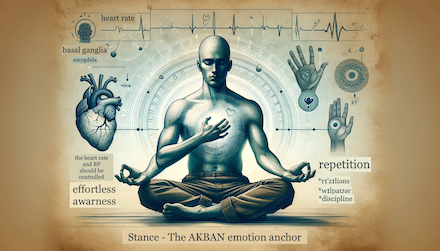Respectful Guard Stance - the emotion anchor

Here's how to do it: Stand or sit in a relaxed position. Place one hand on your sternum, the bone connecting your rib cages. Feel the tension release. Extend your other hand straight out in front of you. This dual-hand position serves two purposes: it projects sincerity and peace, while also establishing boundaries. Feel your pulse slow down, notice your breathing ease, and observe how it impacts your speech. Use this technique before any verbal encounter you expect to be tense or confrontational.
What to check? Lowered heart rate, relaxation of the chest.
When to Use This Stance? For this specific stance, employ it when you sense a quarrel brewing that you'd rather sidestep, yet you still want to remain alert.
In martial arts, stance (Kamae) and hand positions (Mudra) are more than just physical postures; they're tools for emotional regulation. Why? Because mindset, insight, and reaction need to be anchored in action, especially under stress. Everyone has a plan until they get punched in the face, but as martial artists, we need a plan for after that punch too. The anchor for recalling the plan is stance and movement.
We achieve this by integrating physical moves, breath, and cognitive actions. This integration acts as a "seal," locking in our control and preparedness. So when faced with an unexpected situation, this seal, or Kamae, becomes our go-to response. We have a specific Kamae for every situation that requires one, ensuring we're always prepared, both mentally and physically.
This "seal" isn't just a one-time thing; it's rooted in discipline and repeated practice. Without consistent training, these stances won't stick, especially since they're not one-size-fits-all and have their own learning curves. To make them second nature, especially under stress, you've got to drill them into your working memory. That's why we kick off our emotion regulation program with regulation toolkit.
protocol 30. This protocol leverages the accountability of having a partner to help instill self-discipline, making these stances a reliable tool in your emotional Learn hold-relax in 5th, next lesson